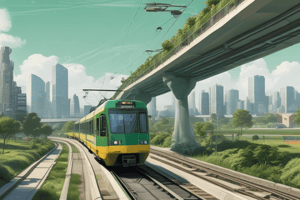Podcast
Questions and Answers
What is a key focus of green building design and sustainable practices?
What is a key focus of green building design and sustainable practices?
- Maximizing greenhouse gas emissions
- Using non-environmentally friendly building materials
- Promoting energy wastage
- Minimizing environmental impacts, including air pollution (correct)
How does indoor air quality management contribute to minimizing air pollution?
How does indoor air quality management contribute to minimizing air pollution?
- By limiting natural air purifiers
- By promoting proper ventilation and low-emission building materials (correct)
- By using high-emission building materials
- By reducing the number of indoor plants
Which strategy helps reduce vehicle emissions and air pollution?
Which strategy helps reduce vehicle emissions and air pollution?
- Supporting sustainable transportation options like walking and cycling (correct)
- Encouraging excessive vehicle use
- Promoting car racing events
- Building more highways
What is the purpose of green infrastructure in urban landscapes?
What is the purpose of green infrastructure in urban landscapes?
How do public awareness and education campaigns contribute to combating air pollution?
How do public awareness and education campaigns contribute to combating air pollution?
Which element is NOT part of energy efficiency measures in green building design?
Which element is NOT part of energy efficiency measures in green building design?
What is the purpose of green roofs and walls in urban areas?
What is the purpose of green roofs and walls in urban areas?
How do urban forests contribute to environmental quality in cities?
How do urban forests contribute to environmental quality in cities?
Which sustainable technology helps prevent flooding and reduce pollutant loads entering water bodies?
Which sustainable technology helps prevent flooding and reduce pollutant loads entering water bodies?
How does green infrastructure and urban design contribute to mitigating the urban heat island effect?
How does green infrastructure and urban design contribute to mitigating the urban heat island effect?
What is the main purpose of investing in infrastructure for electric vehicles and bike-sharing programs?
What is the main purpose of investing in infrastructure for electric vehicles and bike-sharing programs?
Why is it important to integrate natural elements into urban environments according to the text?
Why is it important to integrate natural elements into urban environments according to the text?
What is the main purpose of preserving and expanding green spaces, parks, and urban forests?
What is the main purpose of preserving and expanding green spaces, parks, and urban forests?
How does separating industrial activities from residential areas help in minimizing exposure to air pollution?
How does separating industrial activities from residential areas help in minimizing exposure to air pollution?
What is the goal of promoting walking, cycling, public transit, carpooling, and electric vehicles?
What is the goal of promoting walking, cycling, public transit, carpooling, and electric vehicles?
What is the purpose of designing streets with sidewalks, bike lanes, crosswalks, and traffic calming measures?
What is the purpose of designing streets with sidewalks, bike lanes, crosswalks, and traffic calming measures?
How can congestion pricing, parking management, and telecommuting programs contribute to reducing traffic congestion?
How can congestion pricing, parking management, and telecommuting programs contribute to reducing traffic congestion?
What is the significance of implementing sustainable transportation options in urban areas?
What is the significance of implementing sustainable transportation options in urban areas?
Flashcards are hidden until you start studying
Study Notes
Green Building Design and Sustainable Practices
- Energy-efficient HVAC systems, lighting, insulation, and windows reduce energy consumption and greenhouse gas emissions, contributing to air pollution mitigation.
- Implementing strategies to enhance indoor air quality, such as proper ventilation, low-emission building materials, and indoor plants that act as natural air purifiers.
- Promoting sustainable transportation options, such as walking, cycling, public transit, and carpooling, to reduce vehicle emissions and air pollution from transportation sources.
Green Infrastructure and Urban Design
- Green roofs and walls absorb air pollutants, reduce stormwater runoff, insulate buildings, and improve energy efficiency.
- Urban forests and tree canopies sequester carbon dioxide, provide shade, filter air pollutants, and enhance biodiversity in urban areas.
- Permeable surfaces capture and filter stormwater runoff, prevent flooding, and reduce pollutant loads entering water bodies.
- Cool pavements and reflective surfaces minimize heat absorption, reduce surface temperatures, and mitigate urban heat island effects in densely populated areas.
Green Space Preservation and Urban Planning
- Preserving and expanding green spaces, parks, and urban forests enhance air quality, provide natural ventilation, mitigate urban heat island effects, and promote physical and mental well-being.
- Industrial zoning and buffer zones separate industrial activities from residential and sensitive land uses to minimize exposure to air pollution and industrial emissions.
Transportation Planning and Traffic Management
- Sustainable transportation options, such as walking, cycling, public transit, carpooling, and electric vehicles, reduce greenhouse gas emissions, alleviate traffic congestion, and improve air quality.
- Complete Streets Design accommodates multiple modes of transportation and prioritizes pedestrian and cyclist safety.
- Traffic demand management strategies, such as congestion pricing, parking management, and telecommuting programs, reduce vehicle miles traveled, traffic congestion, and vehicle emissions.
Studying That Suits You
Use AI to generate personalized quizzes and flashcards to suit your learning preferences.




